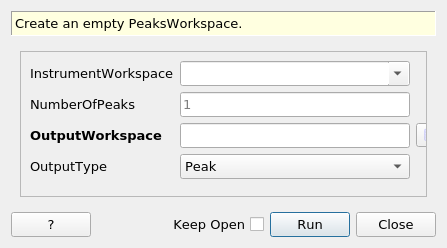\(\renewcommand\AA{\unicode{x212B}}\)
CreatePeaksWorkspace v1¶

CreatePeaksWorkspace dialog.¶
Summary¶
Create an empty PeaksWorkspace.
See Also¶
Properties¶
Name |
Direction |
Type |
Default |
Description |
|---|---|---|---|---|
InstrumentWorkspace |
Input |
An optional input workspace containing the default instrument for peaks in this workspace. |
||
NumberOfPeaks |
Input |
number |
1 |
Number of dummy peaks to initially create. |
OutputWorkspace |
Output |
IPeaksWorkspace |
Mandatory |
An output workspace. |
OutputType |
Input |
string |
Peak |
Output peak workspace type, default to full peak workspace. Allowed values: [‘Peak’, ‘LeanElasticPeak’] |
Description¶
This algorithm can be used to create a:
PeaksWorkspace (Default, or when OutputType is set to Peak.)
LeanElasticPeaksWorkspace (when OutputType is set to LeanElasticPeak)
Use LoadIsawPeaks v1 or FindPeaksMD v1 to create a peaks workspace with peaks.
This workspace can serve as a starting point for modifying the PeaksWorkspace, using the GUI or python scripting, for example.
If the input workspace is a MDWorkspace then the instrument from the first experiment info is used.
Usage¶
Example: An empty table, not tied to an instrument
ws = CreatePeaksWorkspace()
print("Created a {} with {} rows".format(ws.id(), ws.rowCount()))
Output:
Created a PeaksWorkspace with 0 rows
Example: Create an empty LeanElasticPeaksWorkspace, not tied to an instrument
ws = CreatePeaksWorkspace(NumberOfPeaks=0, OutputType="LeanElasticPeak")
print("Created a {} with {} rows".format(ws.id(), ws.rowCount()))
Output:
Created a LeanElasticPeaksWorkspace with 0 rows
Example: With a few peaks in place
sampleWs = CreateSampleWorkspace()
ws = CreatePeaksWorkspace(InstrumentWorkspace=sampleWs,NumberOfPeaks=3)
print("Created a {} with {} rows".format(ws.id(), ws.rowCount()))
Output:
Created a PeaksWorkspace with 3 rows
Categories: AlgorithmIndex | Crystal\Peaks | Utility\Workspaces
Source¶
C++ header: CreatePeaksWorkspace.h
C++ source: CreatePeaksWorkspace.cpp
